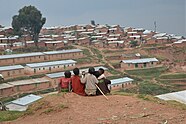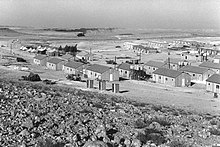
Back مخيم لاجئين Arabic Campu de refuxaos AST Qaçqın düşərgəsi Azerbaijani Kampung tetira BEW Бежански лагер Bulgarian Camp de refugiats Catalan Uprchlický tábor Czech Gwersyll ffoaduriaid Welsh Flygtningelejr Danish Flüchtlingslager German





A refugee camp is a temporary settlement built to receive refugees and people in refugee-like situations. Refugee camps usually accommodate displaced people who have fled their home country, but camps are also made for internally displaced people. Usually, refugees seek asylum after they have escaped war in their home countries, but some camps also house environmental and economic migrants. Camps with over a hundred thousand people are common, but as of 2012, the average-sized camp housed around 11,400.[1] They are usually built and run by a government, the United Nations, international organizations (such as the International Committee of the Red Cross), or non-governmental organization. Unofficial refugee camps, such as Idomeni in Greece or the Calais jungle in France, are where refugees are largely left without the support of governments or international organizations.[2]
Refugee camps generally develop in an impromptu fashion with the aim of meeting basic human needs for only a short time. Facilities that make a camp look or feel more permanent are often prohibited by host country governments. If the return of refugees is prevented (often by civil war), a humanitarian crisis can result or continue.
According to UNHCR, most refugees worldwide do not live in refugee camps. At the end of 2015, some 67% of refugees around the world lived in individual, private accommodations.[3] This can be partly explained by the high number of Syrian refugees renting apartments in urban agglomerations across the Middle East. Worldwide, slightly over a quarter (25.4%) of refugees were reported to be living in managed camps. At the end of 2015, about 56% of the total refugee population in rural locations resided in a managed camp, compared to the 2% who resided in individual accommodation. In urban locations, the overwhelming majority (99%) of refugees lived in individual accommodations, compared with less than 1% who lived in a managed camp. A small percentage of refugees also live in collective centres, transit camps, and self-settled camps.[4]
Despite 74% of refugees being in urban areas, the service delivery model of international humanitarian aid agencies remains focused on the establishment and operation of refugee camps.[5]
- ^ UNHCR: "Displacement: The New 21st Century Challenge," 2012; p. 35.
- ^ Smith, Sean (10 August 2015). "Migrant life in Calais' Jungle refugee camp – a photo essay". The Guardian. Retrieved 8 February 2016.
- ^ Refugees, United Nations High Commissioner for. "UNHCR Global Trends 2015". United Nations High Commission for Refugees.
- ^ Corsellis, Tom; Vitale, Antonella (2005). Transitional Settlement: Displaced Populations. Oxfam. ISBN 9780855985349 – via Google Books.
- ^ "From sector to system: reform and renewal in humanitarian aid". International Rescue Committee (IRC). 27 April 2016.